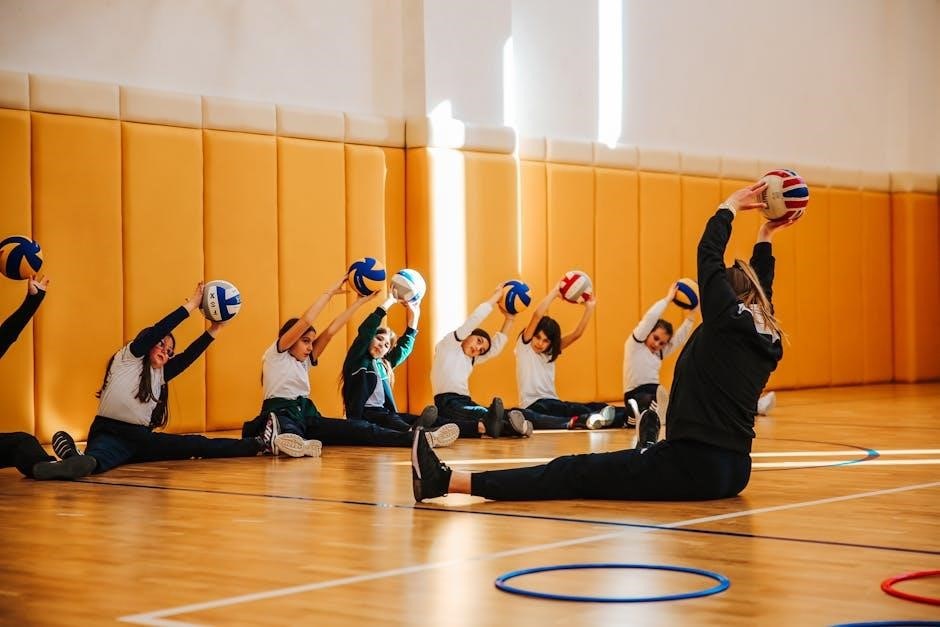Instructional practices are strategies educators use to enhance learning experiences, ensuring students achieve academic goals. They include explicit instruction, project-based learning, and technology integration, aiming to improve student outcomes and engagement effectively.
Definition of Instructional Practices
Instructional practices refer to the methods and strategies educators use to deliver content, engage students, and promote learning. These practices are designed to create effective learning environments, align with curriculum goals, and address diverse student needs. They encompass a wide range of activities, from lectures and discussions to hands-on experiments and technology integration. Effective instructional practices are often research-based, adaptable, and focused on improving student outcomes. They play a critical role in fostering academic achievement, critical thinking, and skill development, making them foundational to successful education.

Types of Instructional Practices
Instructional practices encompass various teaching methods such as lectures, discussions, hands-on activities, and technology integration. These approaches cater to different learning styles and educational objectives effectively.
Explicit Instruction
Explicit instruction is a structured, teacher-led method where concepts are clearly demonstrated and explained. It involves modeling tasks, providing step-by-step guidance, and offering immediate feedback. This approach is particularly effective for introducing new skills or complex ideas, ensuring students understand foundational knowledge before progressing. It often includes drills, practice exercises, and checks for understanding to reinforce learning. Explicit instruction is widely used in various subjects, especially in literacy and mathematics, to build proficiency systematically.
Project-Based Learning
Project-Based Learning (PBL) is an instructional approach where students engage in extended, in-depth projects that promote critical thinking and problem-solving. These projects often involve real-world applications, encouraging collaboration and creativity. PBL is student-centered, allowing learners to take ownership of their education by exploring topics of interest. It fosters skills like teamwork, communication, and time management, preparing students for future challenges. By focusing on meaningful tasks, PBL enhances engagement and deepens understanding, making learning both relevant and impactful.
Flipped Classroom
The Flipped Classroom is an instructional practice that reverses traditional teaching methods. Students engage with pre-recorded lessons or materials at home, freeing class time for interactive activities. This approach uses technology to deliver instruction, enabling personalized learning and hands-on application. It promotes collaborative problem-solving and allows teachers to address individual needs. By shifting the focus from lectures to active learning, the Flipped Classroom enhances engagement and understanding, making it a versatile and effective instructional strategy.
Personalized Learning
Personalized learning tailors instruction to meet individual students’ needs, skills, and interests. It involves adapting content, pace, and learning pathways to ensure each student achieves their full potential. Technology plays a key role, enabling real-time data collection and adaptive learning tools. This approach fosters engagement, as students take ownership of their learning journey. Personalized learning also promotes equity by addressing diverse learning styles and abilities, ensuring all students have access to meaningful opportunities for growth and success in the classroom.
Importance of Instructional Practices
Instructional practices are crucial for fostering student engagement, improving academic achievement, and preparing learners for future challenges. They ensure effective teaching methods, tailored to diverse student needs, enhancing overall education quality.
Enhancing Student Engagement
Effective instructional practices significantly enhance student engagement by creating interactive and meaningful learning experiences. Strategies like project-based learning and flipped classrooms encourage active participation, making lessons more relevant and interesting. Incorporating technology, such as educational software, also captivates students and caters to diverse learning styles. Engaged students are more likely to participate in class discussions, collaborate with peers, and take ownership of their learning. Additionally, personalized learning approaches ensure that each student’s needs are met, fostering motivation and a deeper connection to the material. This leads to improved academic outcomes and a more enjoyable educational experience.
Improving Academic Achievement
Instructional practices play a pivotal role in improving academic achievement by providing structured, research-backed approaches to teaching. Techniques such as formative assessments and data-driven instruction allow educators to monitor progress and tailor lessons to meet student needs. The use of technology and multimedia enhances understanding and retention, while strategies like differentiated instruction ensure all learners can access the curriculum. By fostering a focus on higher-order thinking and problem-solving, effective instructional practices not only boost test scores but also prepare students for long-term success in academics and beyond.

Key Characteristics of Effective Instructional Practices
Effective instructional practices are structured, evidence-based, and tailored to student needs, fostering engagement and deeper understanding through interactive and adaptable learning environments.
Alignment with Learning Objectives
Alignment with learning objectives ensures instructional practices are purposeful and targeted, directly connecting teaching methods to desired student outcomes. This focus enhances academic achievement by concentrating efforts on measurable goals. Effective alignment involves clear planning and continuous assessment, allowing educators to refine strategies based on student performance. By maintaining this alignment, teachers ensure that all activities contribute meaningfully to student learning and understanding, fostering a coherent and directed educational experience that also enhances student engagement.
Use of Technology and Multimedia
Technology and multimedia are integral to modern instructional practices, enhancing engagement and understanding. Tools like educational software, interactive simulations, and multimedia content cater to diverse learning styles, making complex concepts accessible. These resources enable personalized learning experiences, fostering deeper comprehension. By integrating technology, educators can prepare students for the demands of a digitally driven world, ensuring they develop essential 21st-century skills. This approach not only enriches the learning environment but also supports innovative teaching methods that cater to the evolving needs of today’s students.
Implementation Strategies
Effective instructional practices involve implementing strategies such as differentiated instruction, formative assessments, and collaborative learning to create engaging and personalized learning experiences for all students.
Differentiated Instruction
Differentiated instruction is a teaching strategy that addresses diverse learning needs by varying content, process, or product. It involves using formative assessments to identify student strengths and gaps, then tailoring lessons accordingly. Technology, flexible grouping, and personalized tasks are key tools. This approach fosters engagement by aligning learning with individual interests and abilities, ensuring all students can succeed. By catering to varied learning styles, differentiated instruction promotes equity and maximizes each student’s potential for growth and understanding.
Formative Assessment
Formative assessment is an instructional practice used to monitor student learning during lessons. It involves using various tools and techniques, such as Exit Tickets, Think-Pair-Share, and quizzes, to gather real-time feedback. This approach helps teachers identify gaps in understanding and adjust instruction accordingly. Students also benefit by gaining clarity on their progress and areas needing improvement. Formative assessment strategies, like Dylan Wiliam’s five key techniques, emphasize the importance of timely, actionable feedback to enhance learning outcomes and engagement in the classroom.
Collaborative Learning
Collaborative learning is an instructional practice where students work together in groups to achieve common learning goals. This approach fosters active participation, communication, and problem-solving skills. By engaging in group discussions, peer teaching, and shared activities, students develop mutual respect and teamwork. Collaborative learning encourages students to share diverse perspectives, promoting deeper understanding and critical thinking. Teachers act as facilitators, guiding interactions and ensuring all students contribute. This method not only enhances academic performance but also prepares students for real-world collaboration, making it a valuable instructional strategy in diverse classrooms.
Problem-Based Learning
Problem-Based Learning (PBL) is an instructional practice where students engage in real-world, open-ended problems to develop critical thinking and problem-solving skills. This approach encourages active learning by presenting complex scenarios that require research, collaboration, and application of knowledge. PBL fosters creativity, as students design solutions and reflect on outcomes. Teachers act as facilitators, guiding students through inquiry and exploration. This method enhances student engagement and prepares them for real-world challenges, making it a powerful strategy for deep, meaningful learning experiences in diverse educational settings.

Effective Instructional Practices in Diverse Classrooms
Effective instructional practices in diverse classrooms involve tailored strategies to meet varied student needs, fostering inclusivity and engagement through culturally responsive teaching and Universal Design for Learning (UDL).
Culturally Responsive Teaching
Culturally responsive teaching involves creating an inclusive learning environment that respects and values students’ diverse backgrounds. This approach integrates students’ cultural experiences into the curriculum, fostering engagement and equity. Teachers use culturally relevant materials, encourage diverse perspectives, and promote cross-cultural understanding. By acknowledging and celebrating differences, educators help students feel valued, which enhances their academic performance and social growth. This practice ensures that all students, regardless of their cultural identity, have opportunities to succeed and thrive in the classroom.
Universal Design for Learning (UDL)
Universal Design for Learning (UDL) is an instructional practice that ensures learning environments are accessible and engaging for all students. It focuses on flexibility in curriculum design, allowing students to engage, represent, and act upon information in ways that suit their individual needs. UDL emphasizes providing multiple means of engagement, representation, and action to accommodate diverse learning styles. By incorporating multimedia resources, adjustable assessments, and varied interaction methods, educators create inclusive classrooms. This approach ensures that all students, regardless of abilities, can access and benefit from the learning experience, fostering academic success and independence.

Challenges in Implementing Instructional Practices
Implementing instructional practices often requires substantial time, resources, and teacher training. It also demands adaptability to address diverse student needs and integrate new technologies effectively.
Resistance to Change
Resistance to change is a common challenge when implementing new instructional practices. Teachers and students may hesitate to adopt innovative methods due to familiarity with traditional approaches. This reluctance can stem from discomfort with technology, fear of failure, or skepticism about the effectiveness of new strategies. Addressing resistance requires clear communication, professional development, and support systems to ease transitions. Encouraging collaboration and providing incentives can also help overcome barriers and foster a culture of adaptability and continuous improvement in educational settings.
Classroom Management
Classroom management is crucial for effective instructional practices, involving strategies to create a structured and productive learning environment. It includes setting clear expectations, organizing resources, and minimizing disruptions. Teachers use techniques like proactive planning, positive reinforcement, and technology tools to maintain engagement and focus. Effective management enables teachers to deliver instruction seamlessly, ensuring students stay on task and achieve learning objectives. Strong classroom management fosters a respectful and focused atmosphere, essential for academic success and meaningful student-teacher interactions.

Professional Development for Instructional Practices
Professional development involves workshops and training that equip educators with innovative tools and strategies to enhance teaching methods, fostering improved learning experiences and student success.
Workshops and Training
Workshops and training programs are essential for professional development, offering educators hands-on experience with new instructional strategies. These sessions often include interactive activities, demonstrations, and collaborative discussions, allowing teachers to explore innovative methods like project-based learning and technology integration. By engaging in such programs, educators gain practical skills and confidence to implement effective instructional practices in their classrooms, ultimately enhancing student engagement and academic achievement. These trainings also provide opportunities for peer learning and feedback, fostering a supportive environment for continuous improvement.

Role of Technology in Instructional Practices
Technology enhances instructional practices by providing interactive tools, educational software, and multimedia resources. It facilitates personalized learning, improves engagement, and enables efficient access to information, enriching the educational experience.
Examples of Educational Software
Educational software plays a vital role in enhancing instructional practices. Tools like Google Classroom facilitate lesson management and collaboration. Kahoot engages students through interactive quizzes, while Duolingo offers personalized language learning. Khan Academy provides free resources for various subjects, and Moodle serves as a comprehensive learning management system. Additionally, Padlet allows interactive discussions, and Quizlet aids in vocabulary building. These tools cater to diverse learning needs, promoting engagement, creativity, and effective assessment in modern educational settings.

Assessment and Feedback in Instructional Practices
Assessment and feedback are crucial for evaluating student progress and understanding. They involve using formative and summative techniques to measure learning outcomes and provide constructive guidance for improvement.
Formative Assessment Techniques
Formative assessments are informal, ongoing evaluations used to monitor student learning during instruction. Techniques include class discussions, exit tickets, and quizzes, helping teachers identify gaps and adjust lessons. They promote active participation and provide immediate feedback, enabling timely interventions. These methods also encourage peer and self-assessment, fostering a reflective learning environment. By using formative assessments, educators can ensure students stay on track and address challenges promptly, enhancing overall academic performance and engagement in the classroom.
Summative Assessment Methods
Summative assessments are formal evaluations conducted at the end of a lesson, unit, or course to measure student learning. They provide a clear picture of mastery by comparing performance against learning objectives. Common methods include final exams, projects, and standardized tests. These assessments help educators determine if objectives have been met and identify areas needing improvement. They also provide valuable data for grading and reporting, ensuring informed decisions about student progression and curriculum effectiveness. Summative assessments play a crucial role in accountability and educational planning.
Engaging Students Through Instructional Practices
Engaging students through instructional practices involves creating interactive and meaningful learning experiences. Strategies like class discussions, debates, and hands-on activities promote active participation and cater to diverse learning styles.
Class Discussions and Debates
Class discussions and debates are dynamic instructional practices that foster critical thinking and communication skills. By encouraging students to express ideas and listen to others, these activities promote engagement and deeper understanding of concepts. They allow teachers to assess students’ comprehension and address misconceptions in real-time. Debates, in particular, teach students to articulate arguments, evaluate evidence, and respect diverse perspectives. These practices also cater to different learning styles, making them inclusive and effective tools for fostering a collaborative and interactive learning environment that prepares students for real-world communication challenges.
Hands-On Activities
Hands-on activities are instructional practices that engage students through direct participation and experimentation. These activities, such as labs, crafts, or simulations, allow students to explore concepts tangibly, enhancing retention and understanding. They encourage critical thinking, creativity, and problem-solving skills. Hands-on learning also promotes collaboration, as students often work in groups to complete tasks. This approach caters to diverse learning styles, making complex ideas more accessible. Additionally, hands-on activities align with formative assessment, enabling teachers to observe and guide student progress effectively. They are particularly effective in STEM subjects, providing practical experiences that mirror real-world applications.

Culturally Responsive Instructional Practices
Culturally responsive instructional practices acknowledge and respect students’ cultural diversity, creating an inclusive learning environment that enhances engagement and academic success by connecting curricula to their backgrounds.
Incorporating Diverse Perspectives
Incorporating diverse perspectives into instructional practices involves integrating varied cultural, racial, and social viewpoints into the curriculum. This approach fosters inclusivity, encouraging students to explore different ideas and traditions. By incorporating diverse texts, images, and resources, educators ensure all students see themselves reflected in the material. This practice breaks down stereotypes, promotes empathy, and prepares students to engage with a global society. It also enhances critical thinking and collaboration, as students learn to appreciate and respect differing opinions. Culturally responsive teaching thrives when diverse perspectives are intentionally woven into daily instruction, creating a richer learning environment for all students.

Data-Driven Instructional Practices
Data-driven instructional practices involve analyzing student performance data to inform teaching decisions. This approach ensures targeted interventions, improving learning outcomes and student achievement effectively through informed strategies.
Using Student Performance Data
Using student performance data involves analyzing assessments, tests, and assignments to track progress and identify learning gaps. This data helps teachers adjust instruction, providing targeted support and enrichment. By regularly reviewing performance metrics, educators can make informed decisions, ensuring interventions are timely and effective. Data-driven insights also foster a culture of accountability and continuous improvement, enabling schools to refine their instructional strategies and enhance overall student outcomes. This approach ensures that teaching methods remain aligned with student needs, promoting academic success and equity in education.
Instructional practices are essential for creating effective learning environments, fostering student engagement, and promoting academic success through evidence-based strategies tailored to diverse student needs and goals.
Instructional practices are strategies educators use to enhance teaching and learning, focusing on student engagement, academic achievement, and personal growth. They include explicit instruction, project-based learning, and technology integration. Effective practices align with learning objectives, incorporate diverse perspectives, and use formative assessments. They address classroom management, cultural responsiveness, and data-driven decisions. These methods foster collaboration, critical thinking, and creativity, ensuring students meet their full potential. By implementing these practices, educators create inclusive, supportive, and dynamic learning environments tailored to student needs and goals.